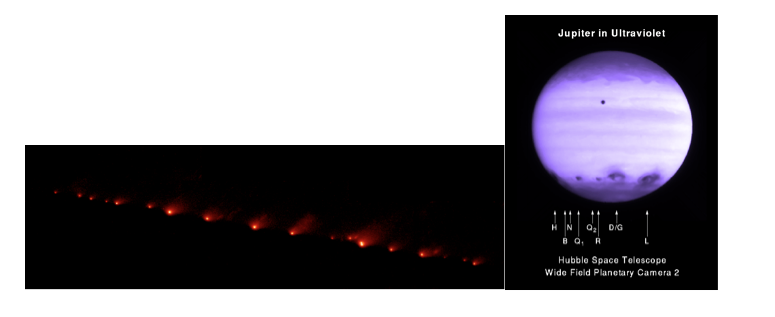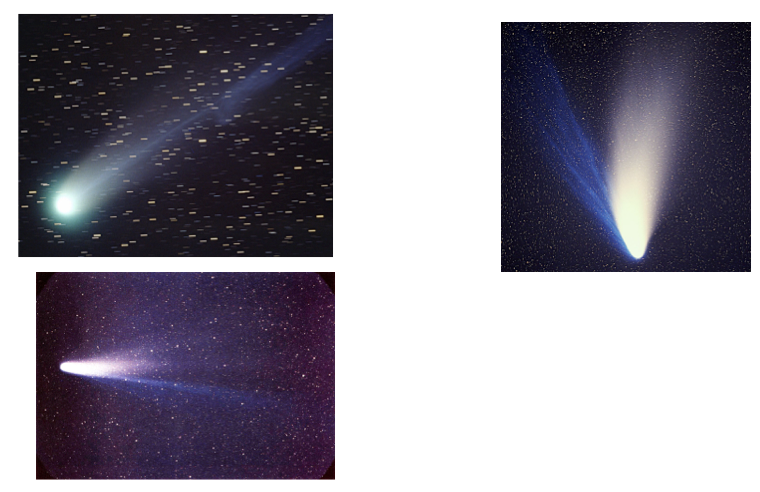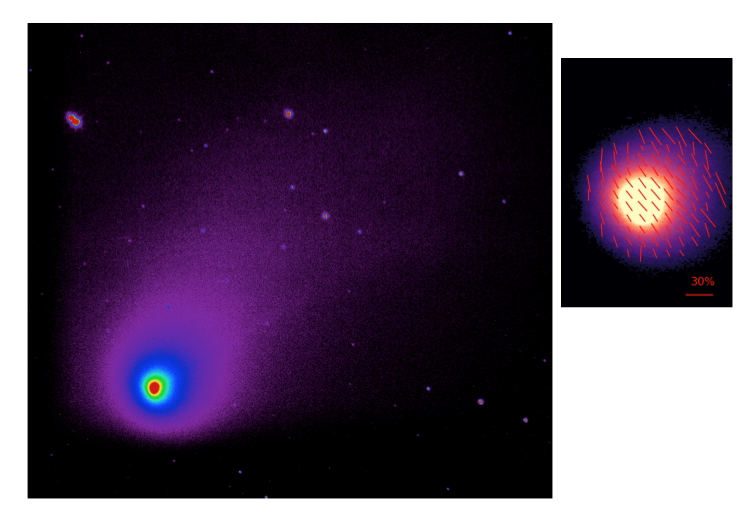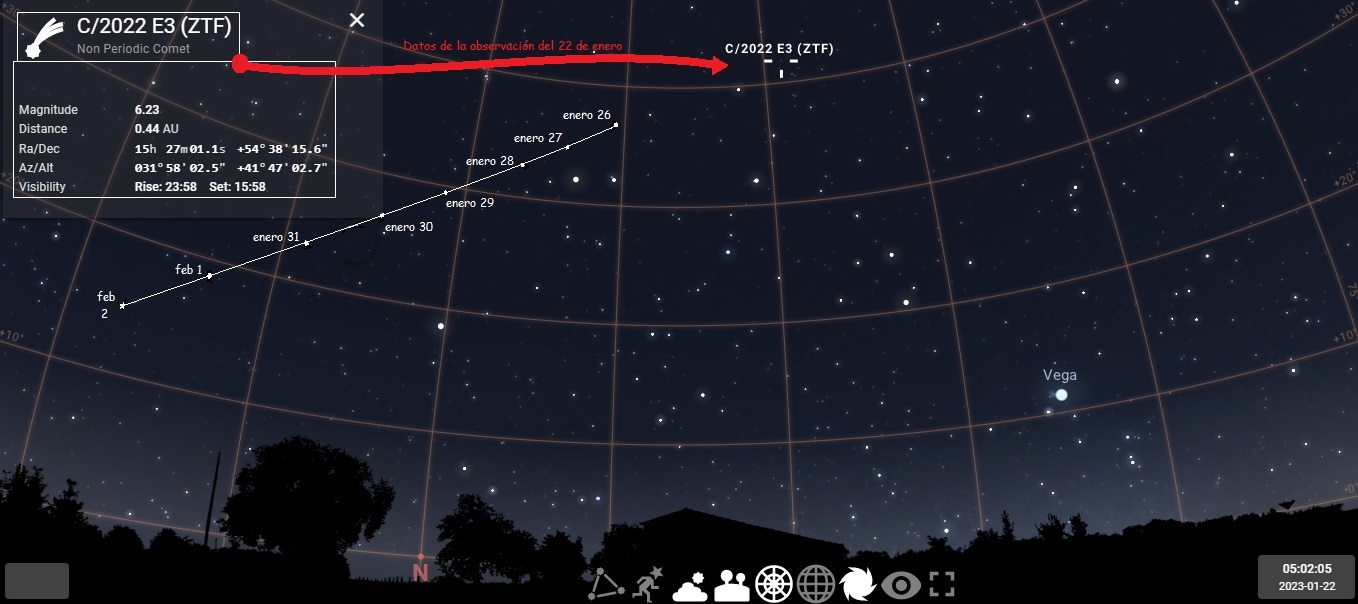'The Green Comet' C/2022 E3
Abraham Luna, Alejandro García Pérez, Eilitia Juárez Marín and Kevin Martínez Vieyra (INAOE-BUAP)
One of the best celestial spectacles that can be observed, sometimes with the naked eye, is the passing of a comet. In the past it was believed that comets were messengers of disasters and catastrophes. Today it is known that these balls of gas, rocks and frozen dust are the mechanisms of chemical transport at the scales of the solar system, producing atmospheres and evolutionary processes on the planets with which they occasionally collide, as was the famous case, in 1994, of the comet Shoemaker-Levy 9 (FIGURE 1).

FIGURE 1: Left: Comet Shoemaker-Levy 9 disintegrated by Jupiter's gravitational pull and on a collision course towards it. Right: Ultraviolet image from the Hubble Space Telescope showing impacts from comet sections. Images taken from Wikipedia https://en.wikipedia.org/
Comets are made up of a rocky core with frozen deposits of volatile material. These messengers come mainly from two well-identified regions: the Oort Cloud and the Kuiper Belt, both regions of vestiges and debris from the formation of our stellar system. From time to time they begin trips towards the central region due to gravitational pushes that occur in the solar system. When they enter the interior region, solar radiation begins to heat their surface, causing the ice to sublime and envelop the nucleus, which is known as the comet's "coma". The nucleus also contains dust of different sizes and both gas and dust break off creating the characteristic tail of these objects, which shines due to the scattering of sunlight. Comets, along with asteroids and other objects, are part of the of what are known as minor objects in the solar system. This set represents the remnants of the formation of our system, so each object contains valuable information. The detailed study of comets allows us to expand our knowledge of the formation of the solar system by studying their chemical composition, since they contain information about their origin.
A few years ago some very showy ones visited us, the Hyakutake and the Hale-Boop in 1996 and 1997, respectively, or in 1986 one with a famous name, the Halley. With different views and trajectories (orbits) and some of them periodically, that is, they return regularly, as in the case of Halley, every 75 years, on average.

FIGURE 2: Comets Hyakutake (top left), Hale-Bopp (top right), and Halley (bottom). Images taken from Wikipedia https://en.wikipedia.org/
At the end of January 2023, we will have a new messenger C/2022 E3 (ZTF), named for being a non-periodic comet, for having been discovered in 2022 and for being the third comet discovered in the first fortnight. of the month of March. The initials ZTF are related to the Zwicky Transient Facility project in which it was discovered. In the networks it has been called the 'green comet', because in photographs it shows predominantly that color. The green emission is due to its chemical composition, since it contains the cyanogen molecule CNNC, a powerful poison, and diatomic carbon, CC, which, when dissociated into C atoms, emits this characteristic color.
Comets typically have two tails, one of ionized gas (bluer) and the other of dust, which glows when scattered by sunlight. Its color, polarization, and intensity depend on its position relative to the Sun and its chemical composition (see FIGURE 2 above of Comet Hale-Bopp and the suggested animation in FIGURE 3). The trajectories of comets depend on their origin, the 'green comet' visits us from the Oort Cloud, a spherical cloud that surrounds the solar system at more than 63,000 times the Earth-Sun distance or a distance equivalent to what it travels light in a year; for that reason, this comet has an orbit outside the plane of the solar system and its orbital period, which cannot be precisely calculated, is estimated to be approximately 50,000 years.

FIGURE 3: Left: Animation of a comet's double tail https://commons.wikimedia.org/wiki/File:Comet_tails.gif Right: Orbital scheme of comet C/2022 E3 taken from https://skyandtelescope.org/astronomy-news/sneak-peek-at-two-promising-ztf-comets/
INAOE did not miss the opportunity to observe such an interesting object and organized observations carried out by different groups made up of Institute researchers, technicians and students from various institutions. Simultaneous observations were made at the Guillermo Haro Astrophysical Observatory in Cananea and in the legendary Schmidt Chamber in Tonantzintla using polarization and photometry techniques, respectively. These observations were carried out in the early hours of Sunday, January 22, 2023, and the results are shown in FIGURE 4.

FIGURA 4: Izquierda: imagen en falso color, tomada en banda visual con la Cámara Schmidt de Tonantzintla. Derecha: vectores de polarización superpuestos a la imagen de grado de polarización en banda H del cercano infrarrojo tomada con el telescopio de 2 metros del OAGH.
For its part, thanks to the size of the field of view of the Schmidt Camera, of approximately 29 x 22 minutes of arc, it was possible to observe the comet in its entirety using the V and Halpha filters. Something interesting that was observed is that the comet presented variations in its brightness around 5:30 in the morning, local time. On the other hand, at the OAGH, its nucleus was observed in infrared polarized emission with the POLICAN polarimeter and the CANICA camera, instruments designed and built at the INAOE. This camera allows us to see a field of 4 x 4 minutes of arc with which the nuclear region of the 'green comet' was recorded. The polarization observed at a wavelength of 1.6 microns, radiation that the human eye cannot see, is consistent with the models both in its degree and in the angle of polarization, demonstrating the presence of dust and light scattering.
The comet passed through its perihelion on January 12, and its perigee will occur until February 2. It will be around this date when the magnitude of the comet is expected to reach a value of 5, the best expected. This end of the month it can be observed in the northern hemisphere all night from 8pm, when it will be at about 20 degrees elevation and going up around the pole star, until about 30 degrees elevation above the horizon at 2am; then it goes back down at 5am to about 20 degrees elevation. Due to its low elevation, it is a bit difficult to observe it due to obstacles that cover the horizon such as trees, houses or buildings.

FIGURE 5: Map of the sky in a northerly direction, observed from Puebla at 5am, where the trajectory that the comet will follow is marked (white line with dots marking different dates) and the position of when it was observed by the INAOE telescopes ( red line marks it and relates it to its parameters of that date and time). The date of February 2 is when it will be easier to observe, since it will have the greatest intensity. Image processed from Stellarium WEB: https://stellarium-web.org/
In FIGURE 5 we show you a map that will help you identify it. Two stars are easy to identify: Vega and the Pole Star in the north, at about 20 degrees elevation, this helps to identify the comet on a dark night. It is recommended to observe it from a place away from the light of the city and with a clear northern horizon. It is suggested to use Stellarium WEB: https://stellarium-web.org/, which is a web application that updates the position and intensity of the object all the time and from anywhere you are observing, you just have to give it permission so that it uses your location, it will show you constellations and other objects at any date and time; it is recommended to practice a little before. A pair of binoculars can improve the experience once the object is located and, finally, something that is essential at this time of year: a good coat.
Luis Enrique Erro # 1, Tonantzintla, Puebla, México, Código Postal 72840, Tel: (222) 266.31.00, difusion@inaoep.mx
This work is licensed under a Creative Commons Attribution-NonCommercial-NoDerivs 2.5 Mexico License.


